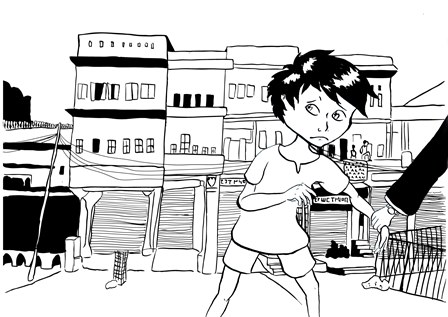Writing about Human Trafficking for Children.
Just over a year ago I traveled to India with Stop The Traffik and Amor Ministries to learn about the issue of human trafficking. (You can read more about my trip here and here.) I had my heart broken multiple times by what I saw and heard, and then was gifted with hope at what can be done to fight this crime and restore those who have been sold. But the question that lingered, and continues to do so, is ‘What will I do now?’
 I knew the trip was a gift; it felt like God had bared his heart to me, shared both his wrath and compassion. But it was not a gift I could take lightly. Long before Ben Parker shared his wisdom with his arachnidly gifted nephew, Jesus had reminded us of the responsibility that comes with what we have been given (Luke 12:48). I could no longer stand idly by, contributing to the supply chain that feeds human trafficking, and shut my heart to what God had shown me. Since then I have explored how to respond and what I can do to spread the word. I’ve spoken to several groups and shared at a couple of churches about what I saw and learned. But what I really wanted to do was write a story. A story for children.
I knew the trip was a gift; it felt like God had bared his heart to me, shared both his wrath and compassion. But it was not a gift I could take lightly. Long before Ben Parker shared his wisdom with his arachnidly gifted nephew, Jesus had reminded us of the responsibility that comes with what we have been given (Luke 12:48). I could no longer stand idly by, contributing to the supply chain that feeds human trafficking, and shut my heart to what God had shown me. Since then I have explored how to respond and what I can do to spread the word. I’ve spoken to several groups and shared at a couple of churches about what I saw and learned. But what I really wanted to do was write a story. A story for children.
Stories are such powerful things, every writer, reader and educator knows it. Jesus knew it and used story as one of his primary teaching mediums. Stories connect where lectures can’t. They, as a friend recently described it, become part of us. They enable us to respond. But how could I write a story about human trafficking for children, young children, without devastating or crippling them?
I knew for a start that I needed to write about trafficking without addressing the issue of sexual slavery. Sadly many, many children are trapped in sexual slavery – but as a proportion of the global trade in people sexual slavery is a small percentage. There are millions of children trapped in other forms of slavery. So I chose to focus on the fashion industry. And I chose a boy as my main character. Both deliberate decisions made with my audience in mind. I then placed my boy in a family that valued both its sons and daughters to expose the truthful cruelty that trafficking happens to loving families as much as with dysfunctional ones. I then looked for the element in this family that would leave it vulnerable to the claims of a trafficker – for if there was anything I learned from my trip to India it’s that traffickers prey on vulnerable people.
 The next important task was for me to figure out how to weave hope as a powerful thread and leave the ending in a place that triggered the desire for action in my audience. To do this I leaned ever so gently on fantasy, introduced some pigeons and left my character in his position of slavery at the end of the story.
The next important task was for me to figure out how to weave hope as a powerful thread and leave the ending in a place that triggered the desire for action in my audience. To do this I leaned ever so gently on fantasy, introduced some pigeons and left my character in his position of slavery at the end of the story.
Yes, I would have liked to set him free. But the reality is that millions of children are not free and their freedom requires action on our behalf. My hope and prayer is that as families, children, church and schools groups use my story they will reach the end only to find it has become part of them. That they are motivated to action and children will be empowered by hope to speak up for children who cannot.
Penny
Penny’s story ‘Akash and the Pigeons’, along with suggestions for age appropriate action, advocacy and flashcard visual aids (illustrated by Alex Hammond) is now available for free download from Stop The Traffik.

I’m pleased to see you tackling a hard topic in a thoughtful sensitive manner for kids. Well done.
One point I wanted to raise: I’m not sure where you got the information that sexual slavery makes up a small percentage of child slavery. According to a recent statistic I read, overall (all demographics) it makes up somewhere between 70 and 80%. I just did a quick search on child sexual trafficking and trafficking for sexual purposes was listed as the number 1 type of child forced labour (source: International Labour Office, Geneva). I think you were right to pick another type of slavery as the subject of your book, but I think it’s good to be clear on the problem.
Hi Lisa, thanks for your comments. I’m glad my article sparked some extra research from you.
The statistics of slavery are very hard to quantify, mainly because it is such a hidden crime.
Sexual slavery receives the majority of attention, and in many cases where someone (especially a child) has been trafficked there is often abuse of a sexual nature that can accompany their imprisonment – even if the purpose of their slavery is not to this end (eg in my story Akash and his workmates would be exposed to abuse of varying kinds by their captors.)
Perhaps instead of the word ‘small’ (which on re-reading does appear to minimise a situation that is no way is minimisable!) I should have just said ‘percentage’. Across the globe people are trafficked into almost every industry imaginable: mining, organ donors, food industry, beverage industry, fashion industry, domestic servitude, construction, labor etc. The numbers are huge and the statistics overwhelming regardless of which ‘industry’ you look at.
Thanks again for stopping by. Feel free to share this story with those who may be able to use it. 🙂
Wow, Penny. This is powerful. I understand your reluctance to write about sexual trafficking with little children. Your book and pictures are excellent.
I wonder if a sequel book might cross over into sexual trafficking issues by discussing personal safety first, and then talk about how some children get caught and taken away by people who would hurt them. I’m sure you have been thinking about these things a lot following your trip.
Hi Janice,
Thanks for your comments! Alex certainly captured the emotions of little Akash, didn’t she?
I have been working for many years on a novel for young adults. It deals directly with the issue of trafficking for sexual slavery. Hopefully I’ll get it finished soon.
That sounds good!
Penny, I applaud you for tackling this subject with a younger audience. My friend, Kathi Macias, has tackled it from an adult perspective with her Freedom series; focusing on a young woman brought over the border by an uncle who uses her for his sex trafficking ring. The woman had been brought over as a young girl and been abused for years.
This is one of the great things about the Internet. Though there are a lot of bad things too, the ability to learn about such horrid things and make a difference is now easier.
Blessings on your work.
Thanks Cheryl.
Your friend’s series sounds interesting – thanks for letting me know about it.
Sometimes the internet feels a bit like wading through muck – I think that’s where sharing useful things comes in handy. You know if a reputable friend recommends a resource that it’s worth looking at.